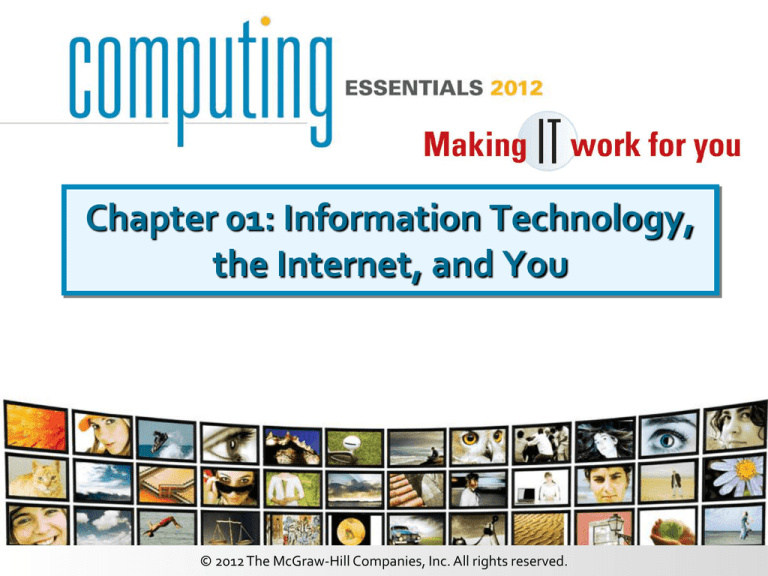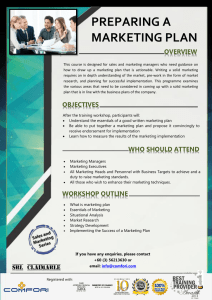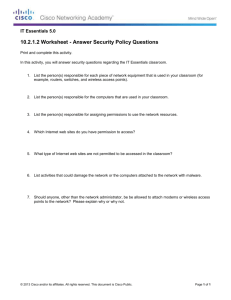
Chapter 01: Information Technology,
the Internet, and You
© 2012 The McGraw-Hill Companies, Inc. All rights reserved.
Computing Essentials 2012: Making IT Work for You
Competencies (Page 1 of 2)
• Explain the five parts of an information system:
people, procedures, software, hardware, and
data.
• Distinguish between system software and
application software.
• Discuss the three kinds of system software
programs.
• Distinguish between basic and specialized
application software.
• Identify the four types of computers and the four
type of microcomputers.
© 2012 The McGraw-Hill Companies, Inc. All rights reserved.
1-2
Computing Essentials 2012: Making IT Work for You
Competencies (Page 2 of 2)
• Describe the different types of
computer hardware including the
system unit, input/output, secondary
storage, and communication
devices.
• Define data and describe document,
worksheet, database, and
presentation files.
• Explain computer connectivity, the
wireless revolution, the Internet,
smartphone, and cloud computing.
© 2012 The McGraw-Hill Companies, Inc. All rights reserved.
1-3
Computing Essentials 2012: Making IT Work for You
Introduction
• Computer competency refers to acquiring computerrelated skills
• Microcomputers are common tools in all
areas of life
• Web-based courses provide alternatives for
people who are homebound or work odd
hours
• The Web provides new ways to
communicate, to find people with similar
interests, and to purchase goods
© 2012 The McGraw-Hill Companies, Inc. All rights reserved.
1-4
Computing Essentials 2012: Making IT Work for You
Five Parts of an Information System
1. People
2. Procedures
3. Software
4. Hardware
5. Data
© 2012 The McGraw-Hill Companies, Inc. All rights reserved.
1-5
Computing Essentials 2012: Making IT Work for You
People
• Most important part of any system
• Contact is …
– Direct
– Indirect
• Computer uses
– Business & Entertainment
– Education & Medicine
© 2012 The McGraw-Hill Companies, Inc. All rights reserved.
1-6
Computing Essentials 2012: Making IT Work for You
Software
• Software is another name for programs
• Two major kinds of software
– System Software
– Application Software
© 2012 The McGraw-Hill Companies, Inc. All rights reserved.
1-7
Computing Essentials 2012: Making IT Work for You
System Software
• A collection of programs – not a single program
– Includes Operating System software, Utilities, and Device Drivers
• Enables the application software to interact with the
hardware, and helps the computer manage its resources
• Two best-known operating systems for microcomputers
are Windows 7 and Mac OS X
Return
© 2012 The McGraw-Hill Companies, Inc. All rights reserved.
1-8
Computing Essentials 2012: Making IT Work for You
Application Software
• End-user software
• Two major categories
– Basic applications
– Specialized applications
Return
© 2012 The McGraw-Hill Companies, Inc. All rights reserved.
1-9
Computing Essentials 2012: Making IT Work for You
Hardware - Types of Computers
•
•
•
•
Supercomputers
Mainframe computers
Minicomputers (or mid-range computers)
Microcomputers
© 2012 The McGraw-Hill Companies, Inc. All rights reserved.
1-10
Computing Essentials 2012: Making IT Work for You
Types of Computers
• Supercomputers– the most powerful; special
high-capacity computers used in very large
corporations
• Mainframe computers– are capable of great
processing speed and data storage; occupy
specially wired, air-conditioned rooms;
insurance companies use to process information
about millions of policyholders
• Minicomputers - known as midrange computers
are refrigerator sized machines used in medium
sized companies or departments in large
companies
© 2012 The McGraw-Hill Companies, Inc. All rights reserved.
1-11
Computing Essentials 2012: Making IT Work for You
• Microcomputers (key term) – least
powerful but most widely used and
fastest-growing type of computers
• Desktop (key term)
• Laptop or notebook (key term)
• Tablet PC (key term)
• Handheld computers (Key Term)
• Palm computers (Key Term)
• Personal digital assistants (PDA)
(Key Term)
© 2012 The McGraw-Hill Companies, Inc. All rights reserved.
1-12
Computing Essentials 2012: Making IT Work for You
Microcomputer Types
• Desktop
• Media center system units
• Notebook or laptop
• Netbooks
• Tablet PC
• Handheld
© 2012 The McGraw-Hill Companies, Inc. All rights reserved.
1-13
Computing Essentials 2012: Making IT Work for You
Desktop Computers
• Desktop computers are small enough to fit on top of or
alongside a desk, yet are too big to carry around
Return
© 2012 The McGraw-Hill Companies, Inc. All rights reserved.
1-14
Computing Essentials 2012: Making IT Work for You
Media Center System Units
• Media center system units blur the line between desktop
computers and dedicated entertainment devices
Return
© 2012 The McGraw-Hill Companies, Inc. All rights reserved.
1-15
Computing Essentials 2012: Making IT Work for You
Notebook or Laptop Computers
• Notebook computers, also known as laptop computers,
are portable, lightweight, and fit into most briefcases
Return
© 2012 The McGraw-Hill Companies, Inc. All rights reserved.
1-16
Computing Essentials 2012: Making IT Work for You
Netbooks
• Similar to notebook computers, but …
– Smaller
– Lighter
– Less expensive
Return
© 2012 The McGraw-Hill Companies, Inc. All rights reserved.
1-17
Computing Essentials 2012: Making IT Work for You
Tablet PC
• In addition to a keyboard, a tablet PC allows you to enter
data, write notes, and select commands using a pen stylus
• Handwritten data is digitized and converted to standard
text that can be further processed by a word processor
Return
© 2012 The McGraw-Hill Companies, Inc. All rights reserved.
1-18
Computing Essentials 2012: Making IT Work for You
Handheld
• Handheld or palm computers, such as Personal digital
assistants (PDAs) and smartphones, are amongst the
smallest computing devices
• These systems typically
combine pen input, writing
recognition, personal
organizational tools, and
communications capabilities
• Smartphones are cell phones
with wireless connections to
the Internet
Return
© 2012 The McGraw-Hill Companies, Inc. All rights reserved.
1-19
Computing Essentials 2012: Making IT Work for You
Microcomputer Hardware
• Four basic categories of equipment:
– System Unit
– Input/Output
– Secondary Storage
– Communications
© 2012 The McGraw-Hill Companies, Inc. All rights reserved.
1-20
Computing Essentials 2012: Making IT Work for You
System Unit
• Two important components
– Microprocessor
– Memory
Return
© 2012 The McGraw-Hill Companies, Inc. All rights reserved.
1-21
Computing Essentials 2012: Making IT Work for You
Input/Output Devices
• Common input devices are the keyboard and the mouse
• Common output devices are printers and monitors
Return
© 2012 The McGraw-Hill Companies, Inc. All rights reserved.
1-22
Computing Essentials 2012: Making IT Work for You
Secondary Storage
• Unlike memory, secondary storage holds data and
programs even if electrical power is not available
• The most important types of secondary media are hard
disks, solid-state storage, and optical disks
Return
© 2012 The McGraw-Hill Companies, Inc. All rights reserved.
1-23
Computing Essentials 2012: Making IT Work for You
Communications
• Communication devices, such as modems, provide
microcomputers with the ability to communicate with
other computer systems across the globe
• Modems modify telephone communications into a form
that can be processed by a computer
• Modems also modify computer output into a form that can
be transmitted across standard telephone lines
Return
© 2012 The McGraw-Hill Companies, Inc. All rights reserved.
1-24
Computing Essentials 2012: Making IT Work for You
Data
• Raw, unprocessed facts
• Processed data becomes information
• Digital data is stored electronically in files
– Document files
– Worksheet files
– Database files
– Presentation files
© 2012 The McGraw-Hill Companies, Inc. All rights reserved.
1-25
Computing Essentials 2012: Making IT Work for You
Document Files
• Created by word processors to save documents such as
memos, term papers, and letters
Return
© 2012 The McGraw-Hill Companies, Inc. All rights reserved.
1-26
Computing Essentials 2012: Making IT Work for You
Worksheet Files
• Created by electronic spreadsheets to analyze things like
budgets and to predict sales
Return
© 2012 The McGraw-Hill Companies, Inc. All rights reserved.
1-27
Computing Essentials 2012: Making IT Work for You
Database Files
• Typically created by database management programs to
contain highly structured and organized data
Return
© 2012 The McGraw-Hill Companies, Inc. All rights reserved.
1-28
Computing Essentials 2012: Making IT Work for You
Presentation Files
• Created by presentation graphics programs to save
presentation materials. For example, a file might contain
audience handouts, speaker notes, and electronic slides.
Return
© 2012 The McGraw-Hill Companies, Inc. All rights reserved.
1-29
Computing Essentials 2012: Making IT Work for You
Connectivity, the Wireless Revolution,
the Internet, and Cloud Computing
• Connectivity
– Sharing of information
– Wireless communication has widespread use
• Computer networks
– Connected communication system of computers
– Largest network is the Internet
• Cloud Computing
– Uses the Internet and the Web to shift many computer
activities from a user’s computer to computers on the
Internet
© 2012 The McGraw-Hill Companies, Inc. All rights reserved.
1-30
Computing Essentials 2012: Making IT Work for You
Careers in IT
• For a complete listing of careers, visit
http://www.computing2012.com/ keyword: careers
© 2012 The McGraw-Hill Companies, Inc. All rights reserved.
1-31
Computing Essentials 2012: Making IT Work for You
A Look to the Future
•
•
•
•
•
•
The Internet and the Web
Powerful Software
Powerful Hardware
Security and Privacy
Organizations
Changing Times
© 2012 The McGraw-Hill Companies, Inc. All rights reserved.
1-32
Computing Essentials 2012: Making IT Work for You
Open-Ended Questions (Page 1 of 2)
• Explain the five parts of an information system.
What part do people play in this system?
• What is system software? What kinds of programs are
included in system software?
• Define and compare basic and specialized application
software.
– Describe some different types of basic applications.
– Describe some types of specialized applications.
© 2012 The McGraw-Hill Companies, Inc. All rights reserved.
1-33
Computing Essentials 2012: Making IT Work for You
Open-Ended Questions (Page 2 of 2)
• Describe the different types of computers.
– What is the most common type?
– What are the types of microcomputers?
• What is connectivity? What are wireless devices and the
wireless revolution? What is a computer network?
What are the Internet and the Web? What is cloud
computing?
© 2012 The McGraw-Hill Companies, Inc. All rights reserved.
1-34



